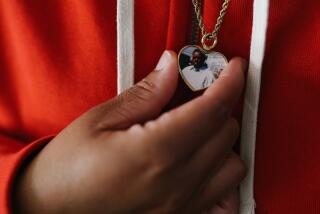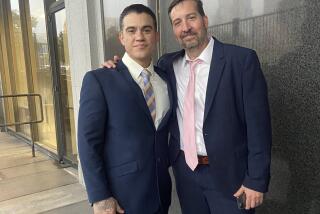Slayer Acquitted of Escape Charge : Orange County Jury Convinced He Was Beaten, Fled for His Life
- Share via
A convicted murderer’s arguments persuaded an Orange County jury Friday that he should be acquitted of escape charges because he had been beaten in jail and had fled for his life.
The Superior Court verdict, which stunned the Sheriff’s Department, came in the escape trial of Ivan Von Staich, 32, who is serving a sentence of 37 years to life for the 1983 claw hammer attack on his girlfriend and the murder of her husband.
Von Staich escaped from the Orange County Jail on Jan. 26, 1986, and was caught in Massachusetts about a month later. He said that the Orange County sheriff’s deputies who were his guards had beaten him.
He acted as his own attorney in the escape trial, using a rare and seldom-successful legal interpretation called “defense of necessity.” That defense allows for acquittal on an escape charge if the escapee can prove several things, including that his or her life was in danger.
Jurors Were Impressed
At the time of the escape, Von Staich was awaiting sentencing on the assault and murder charges. He will now be sent to state prison, but the verdict Friday means that no time will be added for the escape.
“I am completely astounded at the decision,” said Lt. Richard J. Olson, spokesman for the Sheriff’s Department.
Deputy Dist. Atty. William Overtoom, who prosecuted the case, said he was “disappointed” and that he believes “the jurors were confused” by the complexity of the case.
Jurors, in interviews, said they were impressed with the way Von Staich conducted himself during the trial, but they acknowledged that they did not believe all of his testimony. They said, however, that the prosecution failed to disprove many points that Von Staich had raised, including his contention that he was beaten.
“We knew he was a convicted felon, but all of us on the jury decided he should be treated as innocent (of the jail escape charge) unless we found a preponderance of evidence against him, and we did not,” said jury foreman Kevin Paul Little, 23, of Garden Grove.
Von Staich escaped with another inmate, Robert J. Clark, 23, of Palm Springs. Clark was captured a week later at a Tustin motel. He was convicted of murder and pleaded guilty to the escape charge, and he is now in San Quentin Prison.
Von Staich, after his arrest in Massachusetts, was returned to Santa Ana and charged with forcible escape. Had he been convicted of that charge, up to 6 years could have been added to his sentence. The jury also had the option of finding Von Staich guilty of simple escape--that is, without force--which could have added up to 3 years’ time to his prison term.
His trial before Superior Court Judge Linda Hodge McLaughlin began Feb. 8, and the case went to the jury Wednesday afternoon.
Von Staich--a big, burly man of 6 feet, 2 inches and about 200 pounds--appeared in a sand-colored suit, chest-length beard and long ponytail during the trial. As his own counsel, he cross-examined prosecution witnesses, made motions to the court, and talked to the judge.
Bribery Assertion
In a meeting with prosecutor Overtoom outside the courtroom after the trial was recessed, the jurors indicated that they did not fully believe Von Staich’s contention during the trial that a sheriff’s deputy had been bribed to help with the escape. In testimony, Von Staich said that Deputy Frank Nin had agreed to a deal in which Von Staich and Clark could escape in return for $10,000.
In his testimony, Nin called that accusation a lie. Overtoom had repeatedly branded Von Staich’s description of the escape “preposterous.”
But Santa Ana lawyer Duane Neary, whom McLaughlin appointed as Von Staich’s legal adviser, hammered in his closing arguments Wednesday at the contentions about the circumstances of the escape. Neary told jurors that it was unusual that just one deputy would be on the jail’s rooftop recreation area with Von Staich and Clark, both of whom are big men. Neary also questioned why the inmates were not in leg irons then, and why Nin did not show any physical evidence of having been attacked and overpowered.
Nin had testified that Clark had put him in a chokehold as he was taking Clark to a restroom atop the jail. Nin said that he and Clark fell to the roof in the struggle and that Von Staich then forced him to surrender. Nin said he was then handcuffed inside the restroom, and the two men made their escape.
Von Staich, however, testified that Nin handcuffed himself inside the restroom to make it appear that he had been overpowered.
Neary also noted in his closing arguments that the prosecution did not deny that Von Staich was beaten while he was in custody at the jail.
“The evidence is that Mr. Von Staich, as proven by the photos, was beaten by deputies and beaten severely,” Neary said Wednesday. “He was beaten even though he had a life-threatening condition.”
Von Staich had testified that he has had a bullet lodged in his chest for a long time and that the beatings could have dislodged the bullet and killed him. Neary said that sheriff’s deputies at the jail beat Von Staich because they were blaming him for misconduct by another prisoner.
Overtoom, during the trial, conceded that Von Staich had been beaten in jail. But Overtoom said that Von Staich did not report his fears for his life to any officials during several court appearances made after he suffered head and facial injuries in the jail. He also argued that Von Staich never showed any intent to give himself up to authorities after his escape and thus did not fulfill the requirements of the “defense of necessity.”
One of the requisites for a defense of necessity is that the inmate show that he had tried and not succeeded in getting help for a life-threatening situation. The others are that the inmate’s life must have been in danger, that no force was used in the escape, and that the inmate immediately report to officials once he is safely outside.
Reasoning Described
After he was captured in Massachusetts, Von Staich told The Times that he had gone to that state “because it is 3,000 miles away from the Orange County Jail” and that he did not expect authorities to look for him that far away. He said in that interview that he feared being beaten by Orange County Jail deputies.
Massachusetts officials said that Von Staich unsuccessfully tried to escape from one of the policemen who arrested him on suspicion of loitering.
Neary on Friday said that the defense, which has its origins in a California judicial decision, is “very, very rarely” used. In fact, Overtoom had tried unsuccessfully to persuade McLaughlin to disallow it.
“I think the jurors were confused by the jury instructions,” Overtoom said Friday.
Jury foreman Little, who is an industrial engineer, said the jurors “had a reasonable doubt” that Von Staich used force in his escape.
The prosecution had argued that force was used to subdue Nin and that force against property was used when the two prisoners cut through a chain-link fence atop the jail before they lowered themselves on makeshift ropes to the ground 4 stories below.
Little also said that there was “irrefutable proof” presented during the trial to show that Von Staich had been beaten in jail. However, Little added, “We didn’t know who beat him and why.”
Juror Paul Jackson, 23, of Orange, an assistant machine operator, agreed that jurors were concerned about the beating that Von Staich suffered in jail.
Another juror, Wendy Hammie, 24, an Anaheim mortgage banker, said Von Staich did a good job of defending himself. “He is obviously very intelligent,” she said.
Murder Charge Not Known
The jurors had been told that Von Staich was a convicted felon, but they were never told what he was convicted of. Several jurors asked a reporter outside the court Friday for information about that. Some gasped when they learned he had been convicted of murder.
Von Staich, who is now 32, was convicted in 1985 of the attempted murder of his girlfriend, Cynthia Topper, and the murder of her husband, Richard Topper. According to trial testimony, Von Staich kicked in the door of Topper’s Santa Ana home, beat Robert Topper with a claw hammer and shot him three times. Von Staich also beat Cynthia Topper with the hammer, and she has required brain surgery. Overtoom, during the trial, said that the woman still has brain impairment because of the injuries. “At times she is very lucid, and at other times she’s not all there,” Overtoom said.
More to Read
Sign up for Essential California
The most important California stories and recommendations in your inbox every morning.
You may occasionally receive promotional content from the Los Angeles Times.










